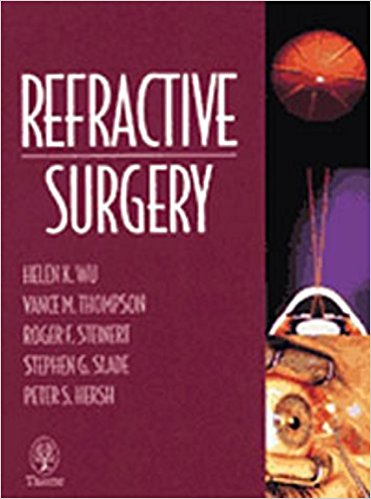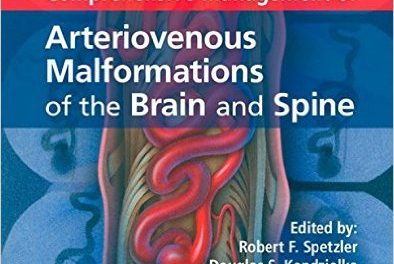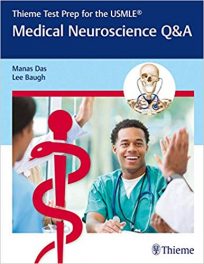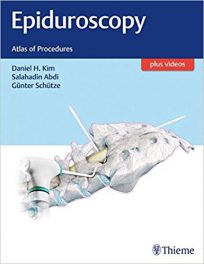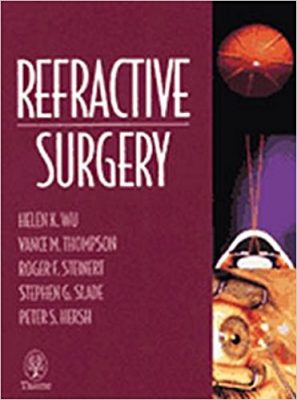 Editors: Helen K, Wu, MD; Vance M. Thompson, MD; Roger F. Steinert, MD; Peter S. Hersh, MD; and Stephen G. Slade, MD
Editors: Helen K, Wu, MD; Vance M. Thompson, MD; Roger F. Steinert, MD; Peter S. Hersh, MD; and Stephen G. Slade, MD
Publisher: Thieme – 492 pages
Book Review by: Nano Khilnani
Refractive surgery had passed its centennial birthday when this book was published in 1999, writes ophthalmologist Dr. George O. Waring, editor of the Journal of Refractive Surgery in the Foreword to this book. He points out that it was William Horatio Bates (1860-1931) who first developed refractive surgery with the well-known Bates method, and authored the book Perfect Eyesight Without Glasses.
This book provides a comprehensive reference and review of major topics in refractive surgery for ophthalmologists, optometrists, and other eye care specialists. As in practically all medical specialties where discoveries occur rapidly, it cannot possibly be fully up-to-date.
The book’s coverage is divided into three major sections, namely: incisional, laser, and lamellar refractive surgery. For each area, this book provides the following, making it a highly useful
And practical tool:
- Historical background
- Patient selection
- Operative technique
- Postoperative care
- Management of complications
Some of the techniques discussed in this book are: intracorneal rings, refractive intraocular lens implantation, holmium laser thermokeratoplasty,
Forty-nine specialists in ophthalmology and related fields in the broad area of eye care authored the 34 chapters of this book of nearly 500 pages. They are from all over the United States and four other countries: Australia, Canada, Germany, and the United Kingdom.
The chapters are organized around seven Sections we name below to give you an overview f what you will find in this volume:
- Introduction
- Corneal Topography
- Incisional Refractive Surgery
- Excimer Laser Refractive Surgery
- Lamellar Refractive Surgery
- Emerging Technologies
- Economics
A very wide range of topics are covered in this book. They include but are by no means limited to the following:
Accommodation, age, anisometropia, anterior chamber, anti-inflammatory drugs, argon-fluorine excimer lasers, astigmatic keratomy, astigmatism, automated lamellar keratoplasty
Baikoff anterior chamberbarometric pressure, Barraquer/ Carriauzo microkeratome, basement membrane of corneal epithelium, bifocals, blepharoptosis, blindness,
Cataracts, centration, Chiron Technolas Keracor, collagen shrinkage procedures, computer-assisted video cartography (CAVK), complications of refractive surgery, contact lenses, contrast sensitivity, cornea, corticosteroids, cry lathe development, cyclopedia
Decent ration, defocus, demographics of refractive errors, dipodic power, diplopic, dopamine affecting eye growth, Dragger lamellating rotokeratome
Economics of refractive surgery, emerging technologies, emmetropia, endophthalmitis, epikeratoplasty, erbium:YAG laser, in refractive keratectomy,
Fibronectin in corneal epithelial basement membrane in wound healing, Flap Maker microkeratome, fluromethalone, flurbiprofen sodium,
Genetic factors, ghost images after presbyopic photorefractive keratectomy, glare, glycosaminoglycans affecting eye growth
Hansatome keratome, haze, hemorrhage (subretinal) after excimer laser refractive surgery, herpes simplex keratitis reactivation after excimer laser refractive surgery
Incisional refractive surgery, infection, interferometry, intracorneal ring,intraocular lenses
Keratokyphosis procedure, keratomileusis, keratophakia, keratoscopy, krypton-fluoride
Let’s take a look at what you will find illustrated and discussed in a typical chapter. In Surgical Techniques of Incisional Refractive Surgery (chapter 9) these are the techniques covered:
- Introduction
- Radial Keratotomy
- History
- Principles
- Patient Selection
- Surgical Planning
- Surgical Technique
- Complications
- Operative Complications: Corneal Perforation
- Postoperative Complications
- Epethelial growth
- Endophalmitis
- Ptosis
- Keratitis
- Traumatic rupture of keratomy incisions
- Refractive complications
- Diurnal fluctuation
- Overcorrection
- Induced astigmatism
- Predictability
- Anterior segment surgery after RK: cataract surgery and penetrating keratoplasty
- Astigmatic Keratotomy
- Historical Perspective on the Surgical Correction of Astigmatism
- Principles
- Patient Selection
- Surgical Planning
- Surgical Techniques:
- Straight or arcuate keratotomy
- Transverse incisions couple with RK incisions
- Semi-radial incisions
- Assymetrical radial incisions
- Trapezoidal AK
- Postkeratoplasty Astigmatism
- Relaxing incisions
- Compression sutures
- Wedge resection
- Complication: Intersecting Incision
- Conclusion
This is an excellent volume on refractive surgery and its varieties. that is quite comprehensive in coverage. The material is well organized and presented, with a detailed focus on surgical techniques and avoidance of complications, .
Editors:
Helen K. Wu, MD is Director of Refractive Surgery at New England Eye Center and Assistant Prpofessor of Ophthalmology at Tufts University School of Medicine in Boston, Massachusetts.
Vance M. Thompson, MD is Director of Refractive Surgery at Sioux Valley Hospital, is affiliated with Ophthalmology Ltd., and is Assistant Professor of Ophthalmology at the University of South Dakota School of Medicine, all in Sioux Falls, South Dakota.
Roger F. Steinert, MD is Surgeon in Ophthalmology at Massachusetts Eye and Ear Infirmary, is affiliated with Boston Eye Surgery and Laser Center, and is Assistant Clinical Professor at Harvard Medical School in Boston, Massacusetss.
Peter S. Hersh, MD is Director of the Cornea and Laser Institute at Hackensack University Medical Center in Teaneck, New Jersey; Associate Professor of Ophthalmology, and Chief of the UMDNJ- New Jersey Medical School in Newark, New Jersey.
Stephen G. Slade, MD is affiliated with the Laser Center of Houston, National Medical Director of TLC (The Laser Center), and is on the Clinical Faculty of the University of Texas in Houston, Texas.

